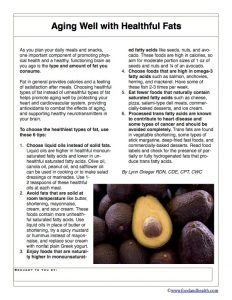Aging Well with Healthful Fats
As you plan your daily meals and snacks, one important component of promoting physical health and a healthy, functioning brain as you age is the type and amount of fat you consume.Fat in general provides calories and a feeling of satisfaction after meals. Choosing healthful types of fat instead of unhealthful types of fat helps promote aging well by protecting your heart and cardiovascular system, providing antioxidants to combat the effects of aging, and supporting healthy neurotransmitters in your brain.To choose the healthiest types of fat, use these 6 tips:
- Choose liquid oils instead of solid fats. Liquid oils are higher in healthful monounsaturated fatty acids and lower in unhealthful saturated fatty acids. Olive oil, canola oil, peanut oil, and safflower oil can be used in cooking or to make salad dressings or marinades. Use 1-2 teaspoons of these healthful oils at each meal.
- Avoid fats that are solid at room temperature like butter, shortening, mayonnaise, cream, and sour cream. These foods contain more unhealthful saturated fatty acids. Use liquid oils in place of butter or shortening, try a spicy mustard or hummus instead of mayonnaise, and replace sour cream with nonfat plain Greek yogurt.
- Enjoy foods that are naturally higher in monounsaturated fatty acids like seeds, nuts, and avocado. These foods are high in calories, so aim for moderate portion sizes of 1 ounce of seeds and nuts and ¼ of an avocado.
- Choose foods that are high in omega-3 fatty acids such as salmon, anchovies, herring, and mackerel. Have some of these fish 2-3 times per week.
- Eat fewer foods that naturally contain saturated fatty acids such as cheese, pizza, salami-type deli meats, commercially-baked desserts, and ice cream.
- Processed trans fatty acids are known to contribute to heart disease and some types of cancer and should be avoided completely. Trans fats are found in vegetable shortening, some types of stick margarine, deep-fried fast foods, and commercially-baked desserts. Read food labels and check for the presence of partially or fully hydrogenated fats that produce trans fatty acids.
By Lynn Grieger RDN, CDE, CPT, CWCReferences:
- National Institute on Aging. Protein, carbohydrate and fats. https://www.nia.nih.gov/health/publication/whats-your-plate/protein-carbohydrates-fats Accessed 12-16-16
- Swanson D, Block R, Mousa SA. Omega-3 Fatty Acids EPA and DHA: Health Benefits Throughout Life. Advances in Nutrition. 2012;3(1):1-7. doi:10.3945/an.111.000893.
- National Institute on Aging. Oils. https://www.nia.nih.gov/health/publication/whats-your-plate/oils Accessed 12-16-16.



